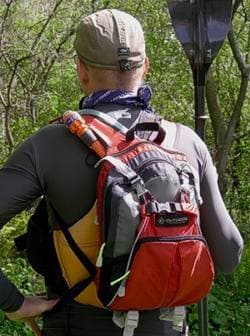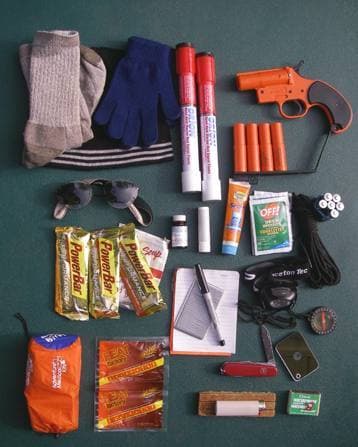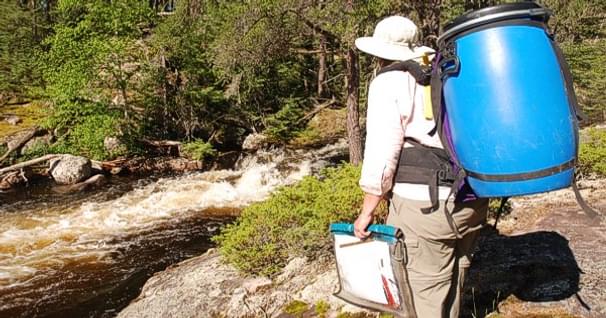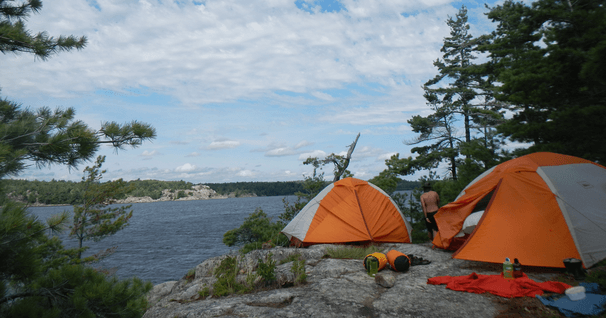A Paddler's Bailout Bag
A good emergency kit can make the difference between a dangerous, life-threatening survival experience and, well... death.
What is a bailout bag? Call it a bailout bag, a ditch kit, bugout bag, or a survival kit; in the context of today's wilderness canoe or kayak traveler, such a kit is intended to sustain a stranded paddler for an unexpected overnight stay, and perhaps as long as 1-3 days. So, the important components will be first-aid supplies, rescue signals, navigation tools should you need to hike out, improvised shelter materials, fire-starting items, and perhaps some food and water.
Because we each travel in slightly different environments, you'll want to tailor your own kit to the places you usually paddle. For example, a kayaker stranded in the northeastern US late in the season may want extra warm clothing and high-calorie food, while one stuck in Mexico's Baja peninsula at the height of summer will forego the long johns in favor of some additional fresh drinking water.
If you've ever pondered the question, "If I were stranded alone on a desert island, what would I most want to have with me?", now is the time to give it some serious consideration.
50 years of lightweight, maneuverable, high-performing kayaks.
Check out this interview with Tom Keane, Eddyline Kayaks Co-Owner, on their journey!
Survival Kit Requirements
Clearly, such a kit must be protected from the elements, so waterproofness is foremost. This may call for a drybag or a hard waterproof box. It must be completely portable, and as compact and cohesive as possible.

If you don't have it on you, you won't have it with you.
Paradoxically, a ditch bag is somewhat similar to a home fire extinguisher: in all statistical likelihood, you will never need it, but when you do, your very life may depend upon it. So, while you don't want to carry the thing around in your lap all day, neither do you want it buried in a hatch somewhere. A comprehensive bailout kit can get somewhat bulky, and probably too large to fit inside the pockets of most PFDs. After experimenting over the years with carrying a drybox between my feet in the cockpit, or a drybag tucked beneath deck bungees, I have finally adopted the old Coast Guard axiom, "If you don't have it on you, you won't have it with you".
There are, after all, very few circumstances in which any self-respecting sea kayaker would ever abandon his kayak, so a bailout bag is intended for the utterly catastrophic event that his kayak abandons him.
With this in mind, I now carry my kit inside the very small backpack which also contains my hydration reservoir. Most of these hydration packs have a variety of zippered compartments and external lash points suitable for stowing all your survival supplies, and of course, include their own water storage. Should you ever be separated from your boat by force (is there any other way?), there will be no time to fumble about to extricate your kit from your kayak as it drifts away.
In addition to a 2-liter (70-oz.) internal water reservoir, such a hydration pack should also offer about 5 to 8 liters (300-500 cubic inches) of cargo space for your survival gear. The pack must have straps long enough to be worn over your PFD, and comfortable enough for all-day paddling. For visibility, bright yellows, reds, or safety oranges are good colors should you need a rescue.
All the gear inside your pack should be contained inside smaller drybags or other waterproof containers, preferably organized by category, much like your larger paddlers' first-aid kit.
It's In The Bag
In general, a good bailout bag will contain some low-volume, high-carbohydrate food such as energy bars; some dry, warm, and moisture-wicking clothing; matches, lighter, and other fire-starting supplies; and numerous other McGyver-esque bits to help the stranded paddler make the best of his time alone in the wilderness.

Many of the more essential items may not be in the survival kit but rather in or on your PFD: VHF marine radio, compass, knife, emergency strobe, whistle, laser flare or signal mirror, compact first-aid kit, etc.. Your wet- or drysuit, and even your PFD, can provide critical warmth when cold and wet, even after you make landfall, so don't ditch these.
If you need to hike out to civilization, you don't want to be overburdened on your way, so don't get carried away with too much gear. Your purpose is not to camp out and thrive in the woods for the proverbial forty days and forty nights, but rather to survive long enough to be rescued or to walk out under your own power. Depending on the terrain of the backcountry, and your usual paddling footwear, you may want to add some more durable, lightweight hiking shoes.
The Emergency Kit List
Here are the contents of my own current bailout bag. As always, it is ever-changing. By all means, add or delete items to create your own survival kit to suit your needs.
First-Aid and Health
- Compact First Aid Kit w/ any personal medications/prescriptions
- Small Chemical Heat Packs
- Firestarting: waterproof matches, windproof piezo butane lighter, tinder, firesteel, etc.
- Spare Eyeglasses w/ Keeper
- Sunglasses
- Insect Repellent
- Sunscreen
- Water and Food
- Water Purifying Tablets
- Energy Bars and Extra Food
Clothing
- Clothing should be location and climate dependent, Polypropylene recommended
- Medium-weight socks
- Watch
- Cap
- Gloves
- Pants
- Longsleeve top
- Lightweight Hiking Shoes or Sneakers
Shelter
- Bag-style Mylar Foil Bivouac Sack
- Swiss Army Knife or Multi-Tool
- Needle and Thread
- Duct Tape, 10'
- Parachute Cord, 1/8", 20'
Rescue
- Signal Flares: large handheld, aerial, gun, and/or smoke flare
- Signal Mirror
- Maps/Charts of local region
- Compass
- Small LED Headlamp, Extra Batteries
- Spare Batteries for VHF Marine Radio
- Small Waterproof Notepad
- Indelible-ink Pen
- Cell Phone, Wallet, Keys
Will It Work? Don't Wait To Find Out
You don't want to wait until your house is on fire before learning that your extinguisher has gone flat. So, you may want to test the contents of your bailout bag under controlled conditions: in the safety of your own backyard or a nearby campground, try spending a night alone outside, using only the contents of your survival kit. If you were cold and wet and exhausted from a long swim, could you competently find and prepare safe drinking water? Start a fire, patch up any injuries, and provide shelter? Feed and clothe yourself, and either signal for rescue or begin making your own way back to civilization? Also, be sure to check the contents of your bailout bag at least annually, and replace weak batteries, outdated energy bars and matches, and other perishables.
Like the fighter pilots of yore, if you are ever forced to part company with your craft, along with all its life-sustaining gear and supplies, your bailout bag is a crucial piece of safety gear you hope you never need to use. But, if and when you find yourself adrift—alone and boatless—you'll be glad you have it.
Paddle safely!
Jeffrey Lee edits Superior Paddling, a kayaking website that seeks to inform, inspire, and compel sea-kayakers to explore and appreciate the endless possibilities of paddling and kayak-touring in the upper Great Lakes region. He considers himself an "enthusiastic student" of the art of sea kayaking.
Related Articles
You'd think choosing a canoe pack, since it's only generally used for carrying a large volume of gear…
The pack barrel's story goes back to the mid-1980s when a group of canoe guides from Ottawa, including…
Kayak camping is not all that different than backpacking - if anything it is easier as you don't have to…
Some years ago at Canocopia in Madison, Wisconsin, I chatted with a young man who had recently completed…





